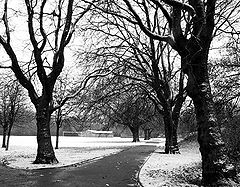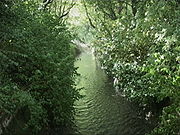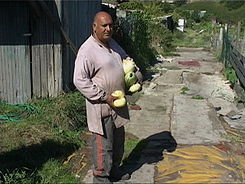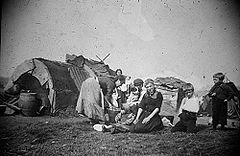
Black Patch Park
Encyclopedia

Park
A park is a protected area, in its natural or semi-natural state, or planted, and set aside for human recreation and enjoyment, or for the protection of wildlife or natural habitats. It may consist of rocks, soil, water, flora and fauna and grass areas. Many parks are legally protected by...
in Smethwick
Smethwick
Smethwick is a town in the Metropolitan Borough of Sandwell, in the West Midlands of England. It is situated on the edge of the city of Birmingham, within the historic boundaries of Staffordshire, Worcestershire and Warwickshire....
, England
England
England is a country that is part of the United Kingdom. It shares land borders with Scotland to the north and Wales to the west; the Irish Sea is to the north west, the Celtic Sea to the south west, with the North Sea to the east and the English Channel to the south separating it from continental...
. It is bounded by Foundry Lane, Woodburn Road, Perrott Street and Kitchener Street, at .
The park, covering over 20 acres (80,937.2 m²), was formerly part of a sparsely populated landscape of commons and woodland (known as The Black Patch), dotted with farms and cottages which has been transformed from heath to farmland then to a carefully laid out municipal park surrounded by engineering companies employing thousands of people; Tangyes
Richard Tangye
Sir Richard Trevithick Tangye was a British manufacturer of engines and other heavy equipment.-Biography:...
, Nettlefolds, (later GKN plc), the Birmingham Railway Carriage and Wagon Company
Birmingham Railway Carriage and Wagon Company
The Birmingham Railway Carriage and Wagon Company was a railway locomotive and carriage builder, founded in Birmingham, England and, for most of its existence, located at nearby Smethwick, with the factory was divided by the boundary between the two places...
, Birmingham Aluminium Castings, ironworks, glassmaking and brewing. These factories, including the Soho Foundry
Soho Foundry
Soho Foundry was a factory created in 1795 by Matthew Boulton and James Watt at Smethwick, West Midlands, England , for the manufacture of steam engines.-History:...
, started by James Watt and Matthew Boulton
Boulton and Watt
The firm of Boulton & Watt was initially a partnership between Matthew Boulton and James Watt.-The engine partnership:The partnership was formed in 1775 to exploit Watt's patent for a steam engine with a separate condenser. This made much more efficient use of its fuel than the older Newcomen engine...
are, but for foundations and frontages, almost all gone.
Much of what is known about Black Patch Park appears in a book by Ted Rudge, developed from an Open University
Open University
The Open University is a distance learning and research university founded by Royal Charter in the United Kingdom...
degree thesis, and published by Birmingham City Council in 2003. Rudge's research records how, from the mid-19th century until they were evicted from it at the start of the 20th, the 'Black Patch' was the camping ground of a community of tent and vardo
Vardo
Vardo can refer to:*Vardø, a municipality in Norway*Vårdö, a municipality in Finland*Vardo , the traditional horse-drawn wagon used by the English Romani Gypsies...
(caravan) dwellers who were to become integrated with 'gaujos' (non-Gypsies) in surrounding districts. The Gypsies on the Black Patch lived on a deep barren layer of furnace waste, which, after their eviction, was cleared down to grass growing soil to create a park .
Situation

Birmingham
Birmingham is a city and metropolitan borough in the West Midlands of England. It is the most populous British city outside the capital London, with a population of 1,036,900 , and lies at the heart of the West Midlands conurbation, the second most populous urban area in the United Kingdom with a...
city centre on the boundary of that city, and is surrounded north, east and south by railway embankments. One of these carries the Birmingham - Wolverhampton part of West Coast main line
West Coast Main Line
The West Coast Main Line is the busiest mixed-traffic railway route in Britain, being the country's most important rail backbone in terms of population served. Fast, long-distance inter-city passenger services are provided between London, the West Midlands, the North West, North Wales and the...
. That and the A41
A41 road
The A41 is a formerly-major trunk road in England that links London and Birkenhead, although it has now largely been superseded by motorways. It passes through or near various towns and cities including Watford, Hemel Hempstead, Aylesbury, Solihull, Birmingham, West Bromwich, Wolverhampton,...
and the Birmingham Canal Navigations
Birmingham Canal Navigations
Birmingham Canal Navigations is a network of navigable canals connecting Birmingham, Wolverhampton, and the eastern part of the Black Country...
' Birmingham to Wolverhampton 'Mainline
BCN Main Line
The BCN Main Line, or Birmingham Canal Navigations Main Line describes the evolving route of the Birmingham Canal between Birmingham and Wolverhampton in England....
' canals - old and new - are arteries of the region's 'North West Corridor of Regeneration'.
In the centre of Black Patch Park, Boundary Brook, which for centuries marked a boundary between Staffordshire
Staffordshire
Staffordshire is a landlocked county in the West Midlands region of England. For Eurostat purposes, the county is a NUTS 3 region and is one of four counties or unitary districts that comprise the "Shropshire and Staffordshire" NUTS 2 region. Part of the National Forest lies within its borders...
and Warwickshire
Warwickshire
Warwickshire is a landlocked non-metropolitan county in the West Midlands region of England. The county town is Warwick, although the largest town is Nuneaton. The county is famous for being the birthplace of William Shakespeare...
, meets Hockley Brook
Hockley Brook
Hockley Brook is a brook, or stream, in north Birmingham, England. It rises just outsdie the city, in Smethwick, and runs through the city's Soho, Hockley and Aston districts, to its confluence with the River Tame, beneath Gravelly Hill Interchange. From there, its waters flow, via the Trent, to...
, which once separated the country villages of Handsworth
Handsworth, West Midlands
Handsworth is an inner city area of Birmingham in the West Midlands, England. The Local Government Act 1894 divided the ancient Staffordshire parish of Handsworth into two urban districts: Handsworth and Perry Barr. Handsworth was annexed to the county borough of Birmingham in Warwickshire in 1911...
and Smethwick
Smethwick
Smethwick is a town in the Metropolitan Borough of Sandwell, in the West Midlands of England. It is situated on the edge of the city of Birmingham, within the historic boundaries of Staffordshire, Worcestershire and Warwickshire....
.
The Park is linked to the Birmingham main line canal via a route through Avery Road that connects it to the West Midlands Sustrans
Sustrans
Sustrans is a British charity to promote sustainable transport. The charity is currently working on a number of practical projects to encourage people to walk, cycle and use public transport, to give people the choice of "travelling in ways that benefit their health and the environment"...
Cycle Route 5, running along the canal towpath, part of a National Cycle Network running from the Cotswolds via Stratford-upon-Avon, Warwick, Birmingham, and Stafford to Stoke-on-Trent in Staffordshire.
Black Patch Park is edged by Foundry Lane to the west and south, Woodburn Road to the north, and Perrott Street and Kitchener Street to the east, beyond which, as far as Handsworth New Road, stretches the triangle of Merry Hill Allotment Gardens. The Midland Metro
Midland Metro
The Midland Metro is a light-rail or tram line in the West Midlands of England between the cities of Birmingham and Wolverhampton via West Bromwich and Wednesbury. It is owned and promoted by Centro, and operated by West Midlands Travel Limited, a subsidiary of the National Express Group , under...
has a stop nearby.
Industrial Revolution

James Brindley
James Brindley was an English engineer. He was born in Tunstead, Derbyshire, and lived much of his life in Leek, Staffordshire, becoming one of the most notable engineers of the 18th century.-Early life:...
supervised the building of a canal between Birmingham and the Black Country
Black Country
The Black Country is a loosely defined area of the English West Midlands conurbation, to the north and west of Birmingham, and to the south and east of Wolverhampton. During the industrial revolution in the 19th century this area had become one of the most intensely industrialised in the nation...
. This waterway came to be known, within 60 years, as the 'old' Main Line Canal after Thomas Telford
Thomas Telford
Thomas Telford FRS, FRSE was a Scottish civil engineer, architect and stonemason, and a noted road, bridge and canal builder.-Early career:...
constructed a straighter, broader New Birmingham Main Line Canal, which opened in 1829 to carry an ever-increasing volume of narrow boat traffic. Brindley and Telford's waterways attracted industrial entrepreneurs including Matthew Boulton
Matthew Boulton
Matthew Boulton, FRS was an English manufacturer and business partner of Scottish engineer James Watt. In the final quarter of the 18th century the partnership installed hundreds of Boulton & Watt steam engines, which were a great advance on the state of the art, making possible the...
, and James Watt who bought 18 acres (72,843.5 m²) by the canal at Merry Hill, about a mile from the firm's Soho Manufactory
Soho Manufactory
The Soho Manufactory was an early factory which pioneered mass production on the assembly line principle, in Soho, Smethwick, England, during the Industrial Revolution.-Beginnings:...
in Handsworth and opened the Soho Foundry
Soho Foundry
Soho Foundry was a factory created in 1795 by Matthew Boulton and James Watt at Smethwick, West Midlands, England , for the manufacture of steam engines.-History:...
in 1796 'for the purpose of casting everything relating to our steam engines'.
As the local population grew, tension developed between them and the travellers. Rudge records that Gypsies and travellers camped on the "Black Patch" from the mid-19th century, not always with approval of local people. Only in the early 20th century, and after several attempts, were the Gypsies finally and forcibly evicted from the 'Black Patch' as rising population density and new land owning assumptions placed greater and greater restriction on their traditional sites.
From being a thriving industrial site, the area was transformed in little more than a lifetime, to a site of dereliction, with the decline of almost all the park's surrounding industrial giants during the economic upheaval of the 1960s. One successful survivor is Avery Weigh-Tronix
Avery Weigh-Tronix
Avery Weigh-Tronix is a company specialising in weighing machines. Its HQ stands on the site of the Soho Foundry overlooking Black Patch Park in Smethwick, Birmingham, England, with a US-based manufacturing and retail manufacturing plant....
on Foundry Lane, the world's largest manufacturers of machines for weighing, counting, measuring and testing, whose main entrance is the frontage of Boulton's and Watt's old Soho Foundry opposite the 'Soho Foundry Tavern'.
Gypsy connection

St. Mary's Church, Handsworth
St. Mary's Church, Handsworth, also known as Handsworth Old Church, is an Anglican church in Handsworth, Birmingham, England. Its ten-acre grounds are contiguous with Handsworth Park and it is just off the Birmingham Outer Circle and south of a cutting housing the site of the former Handsworth...
, is said to have placed a curse on anyone who builds over the Black Patch, the subject of a song by the well known folk artist Bryn Phillips in September 2003.
In 1906 Mrs E J E Pilkington and Tangye Ltd were referred to as legal owners of Black Patch, having put it up for sale after employing land agents to carry out a court imposed eviction of the Gypsies on 26 July 1905. They did not finally relinquish links with the land until a "peaceful eviction" was negotiated by Birmingham Corporation Parks Department on 15 February 1909 . Subsequent stories contribute to reasonable doubt as to who ought to have inherited the Black Patch and who now holds legal title to the Gypsies' old camping ground. Rudge reports that in 1960 Jane Badger, who lived near Black Patch, got into conversation while walking by the Park with a gentleman with an American accent. He claimed he owned the deeds to the land. This story resembles a statement made by Ray Plant, a distant relative of the Black Patch Gypsies, that a family called Murdock once owned the land and gave permission to camp there. According to Ray Plant when the Murdocks emigrated to America they handed over the Black Patch deeds to the Gypsies. The deeds were apparently stolen making any of the gypsies claims to the land unfounded. Many of the gypsy descendants still live in the surrounding area. If you live in that area or have relatives that come from that area you can find very easily on the census..
In July 2005, a memorial plaque to the gypsies was erected.. Sometime in March 2007 this plaque disappeared but has since been replaced.
Creating the Park
Despite past and present doubts about exact ownership the impetus for and organisation of its purchase and development as a public park came from the Birmingham Playgrounds, Open Spaces and Playing Fields Society, chaired by John Nettlefold, a Birmingham Councillor, married into the ChamberlainJoseph Chamberlain
Joseph Chamberlain was an influential British politician and statesman. Unlike most major politicians of the time, he was a self-made businessman and had not attended Oxford or Cambridge University....
family. A mix of public subscription and cash from Smethwick and Handsworth Councils and Birmingham Corporation
Birmingham City Council
The Birmingham City Council is the body responsible for the governance of the City of Birmingham in England, which has been a metropolitan district since 1974. It is the most populated local authority in the United Kingdom with, following a reorganisation of boundaries in June 2004, 120 Birmingham...
raised £12,200. One of the vendors, Mrs Pilkington, donated £500 from the conveyance to assist with their aim of providing a place where people could enjoy fresh air away from the smoky atmosphere of the surrounding factories. The new public space was divided into three; 6 acres (24,281.2 m²) in Handsworth, seven in Smethwick and seven in Birmingham. Further land was acquired to build Perrott Street, widen the Great Western Railway
Great Western Railway
The Great Western Railway was a British railway company that linked London with the south-west and west of England and most of Wales. It was founded in 1833, received its enabling Act of Parliament in 1835 and ran its first trains in 1838...
and provide the Merry Hill Allotments on the other side of Perrott Street. Birmingham Corporation was asked by the Society to lay out and manage Black Patch Park. Unemployed people under the supervision of a Parks' Superintendent carried out this work. It began in January 1909 and was completed in May 1910. The Lord Mayor of Birmingham, Alderman Bowater, formally opened the Black Patch Recreation Ground on 20 June 1911. In 1966 management was taken over by the new Borough of Warley, now Sandwell
Sandwell
Sandwell is a metropolitan borough of the West Midlands with a population of around 289,100, and an area of . The borough is named after Sandwell Priory, and spans a densely populated part of both the Black Country, and the West Midlands conurbation, encompassing the urban towns of Blackheath,...
Metropolitan Council, whose Planning Department confirms that covenants held by Pilkington and Tangye still exist , but until then Black Patch Park was under the stewardship of Birmingham Parks Department.
Campaign to save Black Patch Park

Chaplin
In 2011, a letter, written to him in the 1970s, came to light, suggesting that comedian Charlie ChaplinCharlie Chaplin
Sir Charles Spencer "Charlie" Chaplin, KBE was an English comic actor, film director and composer best known for his work during the silent film era. He became the most famous film star in the world before the end of World War I...
had been born in a gypsy caravan at the park.
Salvation
Agenda item 5 of a Report to the Cabinet Member for Regeneration and Transport, Councillor Bob Badham, Sandwell MBCSandwell
Sandwell is a metropolitan borough of the West Midlands with a population of around 289,100, and an area of . The borough is named after Sandwell Priory, and spans a densely populated part of both the Black Country, and the West Midlands conurbation, encompassing the urban towns of Blackheath,...
, dated 21 February 2007, states:
Within the adopted Unitary Development Plan, sites around Black Patch Park, near to the Soho Foundry were allocated for industrial uses in order to attract investment for a Technology Park. However, this has not come to fruition. A recent Employment Land Survey has revealed that there is no immediate need for further industrial land in this location. As there are no deliverable proposals identified, and to accommodate the wishes of Friends of Black Patch Park to retain the Park area, these allocations have been removed. The land will therefore form a green focal point for any development which takes place on the adjoining sites. The Preferred Option for land adjacent to Soho Foundry has been allocated for Mixed Used which can incorporate industrial and offices, and possibly leisure, community and educational facilities associated to the Foundry once a suitable re-use has been identified. Smethwick Area Action Plan - Preferred Option Document (Cabinet Forward Plan Ref. No. RT089).
External links
- BBC on 'Brumroamin'
- Built Environment Cabinet member Cllr Bob Badham talks about Sandwell MBC's policies to save Black Patch Park http://www.podnosh.com/blog/2007/05/15/blackpatchpodcast/
- Images to supplement this article
- http://www.revolutionaryplayers.org.uk/home.stm Revolutionary Players. History of the Industrial Revolution in the West Midlands. See especially the images at http://www.search.revolutionaryplayers.org.uk/engine/resource/exhibition/standard/default.asp?resource=666 to get an impression of how the Black Patch became named.
- Smethwick Local History Society http://www.smethwicklocalhistory.co.uk/
- Soho Foundry Soho FoundrySoho FoundrySoho Foundry was a factory created in 1795 by Matthew Boulton and James Watt at Smethwick, West Midlands, England , for the manufacture of steam engines.-History:...
- Ted Rudge's 'Romany Memorial'http://www.ted.rudge.btinternet.co.uk/romany_memorial.htm
- Ted Rudge's website on the campaign to save Black Patch Park (including the text of Bryn Phillips song)http://www.ted.rudge.btinternet.co.uk/id42.htm
- http://www.laws.sandwell.gov.uk/ccm/content/urbanform/planninganddevelopment/plans/smethwick-town-plan-in-full.en The Smethwick Town Plan (PDF document). See section on the 'Foundry Lane Action Area' in paras 8.6.1 to 8.6.20, pp. 116–120 (map on page 120) and in Appendix 1, p. 128. As indicated at the conclusion of this article The Smethwick Town Plan is now under review, though any changes supported by Sandwell MBC must be approved by the Secretary of State under the terms of the Planning and Compulsory Purchase Act 2004 http://www.planningportal.gov.uk/england/professionals/en/1085083698055.html

